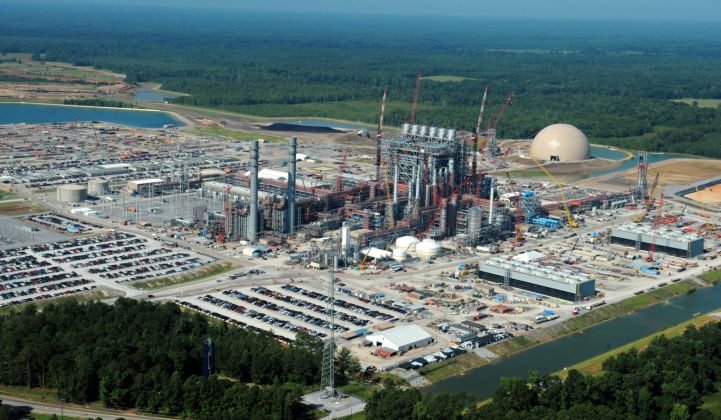In a move that surprised no one, coal giant Southern Company announced Wednesday afternoon that it plans to suspend work on the carbon capture portion of its $7.5 billion power plant in Kemper, Mississippi.
The Kemper plant will now continue to burn natural gas, as it’s done for the past three years, and will not burn coal, nor use technology to capture the plant’s greenhouse gas emissions. Southern Company’s Mississippi Power filed the decision this week after regulators recommended it last week.
It’s a disappointing and frustrating decision for a project that was three years behind schedule, $4 billion over its projected budget, and plagued with issues and lawsuits. When Kemper was first envisioned, it was meant to bring some 12,000 jobs to Mississippi and act as a proving point that coal could be “clean.”
The plant was supposed to use lignite coal, a particularly dirty form of coal, that’s prevalent in the region around the plant. But like many carbon-capture projects before it, the technology used to capture the carbon emissions from coal use could not be scaled to work economically, and after struggling with a variety of issues, the project ran out of money and support.
The New York Times published an in-depth investigation into what was going wrong at Kemper about a year ago, and concluded that the combination of support from the Department of Energy and from then-Governor Haley Barbour created an environment where the power plant owners were encouraged to conceal problems and dramatically underestimate the project cost and timeframe. Employees and lawsuits have alleged fraud and mismanagement.
While Southern Company had taken on $3 billion in extra costs, its utility Mississippi Power had been planning on recouping costs from customers. Now regulators have asked the utility to work with attorneys to figure out a settlement, and have recommended that shareholders eat the costs, rather than ratepayers.
Mississippi, by many measures, is the poorest state in the U.S. Over his tenure (and even before it), Barbour encouraged a range of green projects and companies -- like biofuel company KiOR, solar company Twin Creeks, and smart glass maker View -- to set up shop in the state, and many of those companies failed, leaving the state with lost revenue and scuttled investments. (Although it is notable that View is still operating and raised funds recently.)
Kemper’s failure isn’t just the latest problem for Mississippi’s green projects -- it also impacts for carbon-capture technology in the U.S. as a whole. Kemper follows in the footsteps of FutureGen, a controversial public-private partnership around clean coal that was started and then stalled under the George W. Bush administration, and then underwent an ultimately unsuccessful restart under the Obama administration.
Billions have been allocated and essentially wasted on carbon-capture technology, which was under discussion even back in the Reagan and Clinton administrations.
The big question is whether carbon-capture technology is economically viable at all. It’s been proven to work, but only in a limited way for very large coal plants. Former Mayor Michael Bloomberg called carbon capture “total bullshit,” a “figment of the imagination" and “nonsense” at the recent Bloomberg New Energy Finance conference in April.
However, there is one carbon-capture plant up and running in the U.S. Sited in Texas and called Petra Nova, it is a joint venture between NRG Energy and Japanese firm JX Nippon Oil & Gas Exploration Company. The project started operating in April of this year, and operators say it was on time and budget. It’s being called the biggest coal carbon-capture plant in the world.
Bloomberg New Energy Finance analyst Nicholas Steckler pointed out that Petra Nova uses what’s called post-combustion carbon-capture technology, which burns coal and uses scrubbers to remove the carbon dioxide from the process. The carbon dioxide is then shipped to oil wells to be injected to stimulate under performing wells.
In contrast, Kemper used pre-combustion carbon capture technology, where the plant owners gasified the coal and then aimed to capture the carbon dioxide from the gas. “These are very different technologies,” noted Steckler.
“All eyes will now be on Petra Nova to see how it’s operating,” predicted Steckler. The natural conclusion of one project’s success, and the other project’s failure, might be that post-combustion technology works, while pre-combustion technology doesn’t work.
Such findings might be premature, however, because it’s still very early days for coal carbon-capture projects. A reliable indicator in the future of what works and what doesn’t will likely come from China, which has been investing heavily in clean coal projects. China needs as many new sources of energy as possible, and has been investing far more into cleaner-combusting and more efficient coal plants than the U.S. has.
Steckler also pointed out that Kemper’s turn to natural gas is part of a much wider trend of power companies opting for natural gas over coal. Gas is cleaner, has less policy and reputation risk, and is more flexible. “It’s not a surprise that their Plan B was to switch to gas,” said Steckler.
On Kemper and its carbon-capture demise, Steckler noted: “Power is highly competitive, and power prices are very low. They’re less than half of what they were 10 years ago. It’s really difficult for something so expensive to hang on.”



